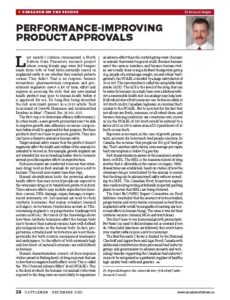Performance Improving Product Approvals
This article written by Dr. Reynold Bergen, BCRC Science Director, originally appeared in the December 2015 issue of Canadian Cattlemen magazine and is reprinted on the BCRC Blog with permission of the publisher.
Last month’s column summarized a North Dakota State University research project where young female pigs were fed burgers made from tofu or beef from naturally-raised or implanted cattle to see whether they reached puberty sooner. They didn’t. That is no surprise, because researchers, pharmaceutical companies and government regulators invest a lot of time, effort and expense in assessing the risks that any new animal health product may pose to human health before it is approved for use. Dr. Sang-Hee Jeong described the risk assessment process in a 2010 article “Risk Assessment of Growth Hormones and Antimicrobial Residues in Meat” (Toxicol. Res. 26:301-313).
The first step is to determine efficacy (effectiveness). In other words, a new growth promotant must be able to improve growth rate, efficiency or carcass composition before it will be approved for that purpose. But these products don’t just have to promote growth. They also can’t pose a threat to animal or human safety.
Target animal safety means that the product doesn’t negatively affect the health and welfare of the animal it intended to be used in. For example, growth implants are not intended for use in breeding heifers due to concerns around possible negative effects on reproduction.
Risk assessments are conducted to ensure that veterinary drugs used in food animals do not pose a risk to humans. These risk assessments have four steps.
Hazard identification looks for potential adverse health effects that may occur if people are exposed to the veterinary drug or its breakdown products in food. These adverse effects may include reproductive disorders, cancer, DNA damage, organ damage, compromised immunity, etc. Lab animals are used to study synthetic hormones that mimic estradiol (zeranol in Ralgro), testosterone (trenbolone acetate in TBA-containing implants), or progesterone (melengestrol acetate in MGA). But much of the knowledge about how these synthetic hormones affect the human body exists because their natural versions have well-defined physiological roles in the human body. In fact, progesterone, estradiol and testosterone are used therapeutically for birth control, menopausal treatments and andropause. So the effects of both extremely high and low levels of natural hormones are well defined in humans.
Hazard characterization consists of dose-response studies aimed at finding levels of drug exposure that are so low that no negative health effects occur. This is called the “No Observed Adverse Effect” level (NOAEL). This is the level at which the humans (or animals) who were exposed to the drug were no more likely to experience an adverse effect than the control group were (humans or animals that weren’t exposed at all). Because humans aren’t the same as monkeys, and because human studies are usually done using a defined therapeutic group (e.g. people of a certain age, weight, sex and ethnic background), the NOAEL is divided by a large safety factor of 10 or 100. This new number is called the acceptable daily intake (ADI). The ADI is the level of the drug that can be eaten by humans on a daily basis over a lifetime without a measurable health risk. An analogy may help here. If all-wheel-drive Ford minivans can be driven safely at 100km/h on dry Canadian highways in summer, that’s similar to the NOAEL. But to account for the fact that not all cars are Fords, minivans, or all-wheel-drive, and because driving conditions are sometimes wet, snowy or icy, the NOAEL of 100km/h would be reduced by a factor of 10 or 100 to arrive at an ADI (speed limit) of 10km/h or 1 km/h.
Exposure assessment, in the case of growth promotants, accounts for how much beef people consume. In Canada, this assumes that people eat 500g of beef per day. That’s another safety factor, since average per capita beef consumption is below 75g per day.
Risk characterization arrives at the Maximum Residue Limit, or MRL. The MRL is the maximum level of drug residue that is allowable in the carcass or organs. Withdrawal times are established, based on studies of how the veterinary drug is metabolized by the animal, to ensure that the drug can be administered safely without exceeding the MRL. The Canadian Food Inspection Agency does random drug testing at federally inspected packing plants to ensure that MRL’s are being observed.
The Joint FAO/WHO Expert Committee on Food Additives concluded that the amount of extra estradiol, progesterone and testosterone consumed in beef from implanted cattle would be incapable of exerting any hormonal effects in human beings. The same is true for their synthetic versions (zeranol, MGA and trenbolone).
You don’t have to use hormonal growth promotants. But there’s no need to feel embarrassed or worried if you do. When label directions are followed, they won’t harm your market cattle or pose a risk to consumers.
Click here to subscribe to the BCRC Blog and receive email notifications when new content is posted.
The sharing or reprinting of BCRC Blog articles is typically welcome and encouraged, however this article requires permission of the original publisher.
We welcome your questions, comments and suggestions. Contact us directly or generate public discussion by posting your thoughts below.
